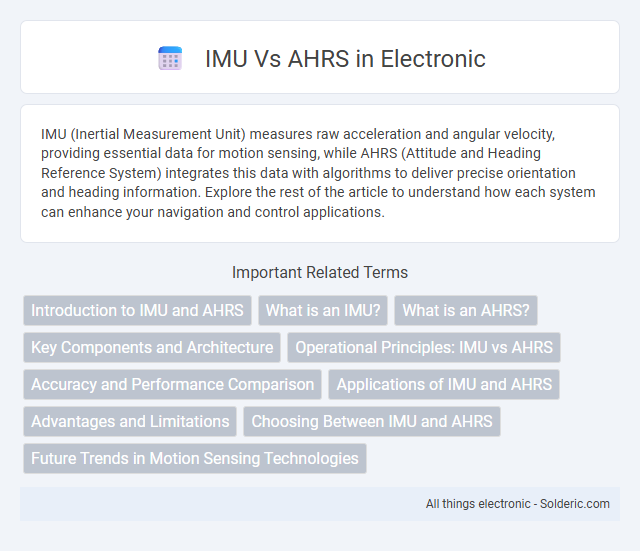IMU (Inertial Measurement Unit) measures raw acceleration and angular velocity, providing essential data for motion sensing, while AHRS (Attitude and Heading Reference System) integrates this data with algorithms to deliver precise orientation and heading information. Explore the rest of the article to understand how each system can enhance your navigation and control applications.
Comparison Table
| Feature | IMU (Inertial Measurement Unit) | AHRS (Attitude and Heading Reference System) |
|---|---|---|
| Sensors Included | Accelerometer, Gyroscope, (optional Magnetometer) | Accelerometer, Gyroscope, Magnetometer |
| Primary Function | Measures raw acceleration and angular velocity | Provides orientation (attitude) and heading information |
| Output | Raw sensor data | Filtered and fused orientation data (yaw, pitch, roll) |
| Data Processing | Minimal, typically raw sensor readings | Advanced sensor fusion algorithms (e.g., Kalman filter) |
| Use Cases | Basic motion detection, inertial tracking | Navigation, robotics, UAV flight control |
| Complexity | Lower | Higher |
| Cost | Generally lower | Generally higher |
Introduction to IMU and AHRS
An Inertial Measurement Unit (IMU) consists of accelerometers and gyroscopes that measure linear acceleration and angular velocity, providing raw motion data essential for navigation and robotics. An Attitude and Heading Reference System (AHRS) builds upon the IMU by integrating additional sensors such as magnetometers and applying sensor fusion algorithms to deliver accurate orientation and heading information. AHRS systems enhance the data from IMUs, enabling precise real-time attitude estimation critical for aviation, autonomous vehicles, and mobile device applications.
What is an IMU?
An Inertial Measurement Unit (IMU) is a sensor device that combines accelerometers, gyroscopes, and sometimes magnetometers to measure linear acceleration, angular velocity, and magnetic field orientation. IMUs provide raw data for motion tracking and orientation estimation in applications ranging from aerospace navigation to mobile devices. Unlike an AHRS, which processes sensor fusion algorithms to deliver attitude and heading solutions, an IMU supplies fundamental motion data without integrated orientation computation.
What is an AHRS?
An AHRS (Attitude and Heading Reference System) is an advanced navigation device that integrates data from multiple sensors, including gyroscopes, accelerometers, and magnetometers, to provide precise orientation information such as pitch, roll, and yaw. Unlike a traditional IMU (Inertial Measurement Unit), which primarily measures angular velocity and linear acceleration, an AHRS uses sensor fusion algorithms to deliver comprehensive attitude and heading data useful for aviation, robotics, and mobile applications. Your system benefits from AHRS when accurate and reliable spatial awareness is critical for real-time navigation and control.
Key Components and Architecture
An Inertial Measurement Unit (IMU) primarily consists of accelerometers, gyroscopes, and sometimes magnetometers that measure raw motion and orientation data. An Attitude and Heading Reference System (AHRS) builds upon the IMU by integrating sensor fusion algorithms and a microprocessor to provide accurate, drift-corrected orientation information such as yaw, pitch, and roll. Understanding the architecture of these systems helps you select the right sensor solution for precise navigation and motion tracking applications.
Operational Principles: IMU vs AHRS
An Inertial Measurement Unit (IMU) operates by measuring linear acceleration and angular velocity using accelerometers and gyroscopes, providing raw data on motion and orientation. An Attitude and Heading Reference System (AHRS) enhances IMU data by integrating magnetometers and applying sensor fusion algorithms to deliver accurate, real-time estimates of three-dimensional orientation. The AHRS compensates for sensor drift and noise inherent in IMUs, enabling reliable attitude, heading, and navigation information.
Accuracy and Performance Comparison
IMUs (Inertial Measurement Units) and AHRS (Attitude and Heading Reference Systems) differ significantly in accuracy and performance; AHRS typically offers superior precision by fusing gyroscope, accelerometer, and magnetometer data through advanced algorithms like Kalman filtering. Your choice between IMU and AHRS impacts navigation and orientation accuracy, as AHRS provides enhanced stability and reduced drift over time compared to standalone IMUs. Performance in dynamic environments favors AHRS, which delivers more reliable heading and attitude estimations critical for applications in aerospace, robotics, and autonomous vehicles.
Applications of IMU and AHRS
IMU (Inertial Measurement Unit) sensors provide raw accelerometer and gyroscope data used in applications such as navigation, motion tracking, and vibration analysis. AHRS (Attitude and Heading Reference System) enhances IMU data with sensor fusion algorithms to deliver precise orientation, making it essential for aerospace, UAV stabilization, and augmented reality systems. Your choice between IMU and AHRS depends on whether you require basic inertial data or fully computed attitude and heading information.
Advantages and Limitations
An Inertial Measurement Unit (IMU) offers high-frequency, raw data on acceleration and angular velocity, making it ideal for applications requiring fast and precise motion tracking, but it lacks built-in sensor fusion which can lead to drift over time. An Attitude and Heading Reference System (AHRS) integrates IMU data with magnetometer readings using advanced sensor fusion algorithms, providing accurate, stable orientation and heading information with reduced drift. However, AHRS systems tend to consume more power and require more computational resources, which can limit their deployment in resource-constrained environments.
Choosing Between IMU and AHRS
Choosing between an IMU (Inertial Measurement Unit) and an AHRS (Attitude and Heading Reference System) depends on the level of orientation and heading information required. IMUs provide raw accelerometer and gyroscope data, suitable for applications needing basic motion sensing without complex sensor fusion. AHRS units integrate magnetometer data with IMU measurements through advanced algorithms, offering precise fused attitude and heading estimates essential for navigation, aerospace, and robotics applications.
Future Trends in Motion Sensing Technologies
Future trends in motion sensing technologies emphasize the integration of AI and machine learning algorithms with IMUs (Inertial Measurement Units) and AHRS (Attitude and Heading Reference Systems) to enhance accuracy and real-time data processing. Advances in sensor miniaturization and low-power consumption are driving widespread adoption in wearable devices, autonomous vehicles, and robotics. The fusion of IMU and AHRS data with GNSS and visual sensors promises to revolutionize navigation and motion tracking by providing robust, drift-free orientation solutions.
IMU vs AHRS Infographic

 solderic.com
solderic.com